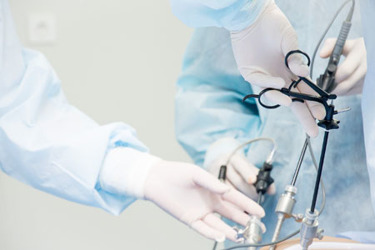Driving Forces In The Laparoscopic Device Global Market
By Nathaniel Bool and Kamran Zamanian, iData Research

The global market for laparoscopic devices is currently experiencing substantial growth, driven by several key factors. Laparoscopic surgery, also known as keyhole surgery, or a type of minimally invasive surgery (MIS), has revolutionized the field of medicine by enabling surgical procedures to be performed through small incisions, aided by cameras and specialized instruments. This article delves into the primary drivers fueling the growth of the global laparoscopic device market, shedding light on the escalating adoption of laparoscopic surgeries, the increasing utilization of direct energy devices and the pivotal role played by ultrasonic devices in shaping the landscape of modern surgical techniques.
Growth In Developing Markets
The laparoscopic device market is not confined to North America and Europe; but is experiencing substantial growth in Latin American and Asia-Pacific markets as well. The Latin American and Asian-Pacific markets are witnessing an increased prevalence of laparoscopic surgeries due to factors such as changing lifestyles, urbanization and rising healthcare awareness. In Latin America, countries like Brazil, Mexico and Argentina are experiencing a surge in laparoscopic procedures, driven by the growing burden of diseases and efforts to improve healthcare infrastructure.
In the Asia-Pacific region, including China, India, and Japan, a rising incidence of diseases necessitating laparoscopic interventions is fueled by an aging population, urbanization and lifestyle changes. In many of these developing economies, laparoscopy is becoming the standard for many types of surgeries that were once performed via laparotomy. Investments in healthcare infrastructure and increasing middle-class populations with higher disposable incomes are further supporting the demand for laparoscopic devices in these regions.
Due to these drivers, the Asia-Pacific and Latin American laparoscopic device markets are poised for substantial growth over the forecast period. As these regions continue to embrace and integrate laparoscopic techniques into their healthcare systems, the market's expansion is expected to create opportunities for manufacturers and contribute significantly to the overall global growth of the laparoscopic device market

Figure 1: Total Laparoscopic Market Value by region, Global, 2023–2030. Access iData’s Global Laparoscopic Device Market Report1 to view more granular data.
Direct Energy Devices
Direct energy devices, including electrosurgical instruments, have become integral to modern laparoscopic surgeries. These devices are designed for precise tissue cutting, coagulation, and sealing during surgical procedures, which means that they offer several advantages to traditional surgical methods. Direct energy devices provide surgeons with precise control over tissue manipulation, minimize collateral damage, and can often reduce complication rates. Additionally, these devices play a pivotal role in achieving hemostasis, which is critical in surgeries involving vascular tissues or organs with significant blood supply. The integration of direct energy devices into laparoscopic procedures not only enhances surgical precision but also contributes significantly to patient safety and optimal outcomes. The utilization of these advanced devices reflects the evolving landscape of minimally invasive surgery, where technological innovations play a central role in reshaping and advancing surgical practices for improved efficiency and patient well-being.
Direct energy instruments streamline surgical procedures by combining multiple functions within a single device, resulting in shorter operating times and reduced anesthesia exposure for patients.2 This efficiency not only benefits patients but also contributes to cost savings in healthcare systems worldwide. As the global prevalence of chronic diseases, including diabetes, cardiovascular disorders, and cancer, continues to rise, the demand for effective and less invasive treatment options has surged. Direct energy devices play a crucial role in addressing the surgical needs of patients with chronic conditions, making them even more indispensable in the field of laparoscopic surgery. The increased precision and reduced complication rates associated with these devices have fueled their widespread adoption, leading to a substantial increase in global sales. Ongoing research and development efforts continue to enhance the technology and user-friendliness of these energy devices, further propelling their adoption and driving the growth of the global laparoscopic device market. As a result, the market is witnessing an uptick in sales, as healthcare providers recognize the value of direct energy instruments in improving patient outcomes and optimizing resource utilization in the face of the growing burden of chronic diseases worldwide.
The largest segment within the direct energy device market is comprised of bipolar instruments, encompassing fundamental tools like forceps as well as advanced tools endowed with vessel sealing and dividing functionalities. Bipolar devices generally command a higher average selling price and are frequently recommended for single-use scenarios.
Another segment of the market are monopolar electrodes, which are affixed to patients during electrosurgery and are paired with hand instruments featuring electrosurgical capabilities. The market for monopolar electrodes is comparatively smaller, as bipolar energy is the preferred choice in laparoscopic surgery that necessitates vessel sealing or dissection, owing to its ease of use.

Figure 2: Direct Energy Device Market by Segment, Global, 2023–2030. Access iData’s Global Laparoscopic Device Market Report1 to view more granular data.
Ultrasonic Devices
Ultrasonic devices, another key innovation in laparoscopic surgery, use high-frequency sound waves for tissue dissection and coagulation. They have become indispensable tools for surgeons due to their ability to operate at lower temperatures, reducing the risk of thermal injury to surrounding tissues. Ultrasonic devices offer enhanced precision, enabling surgeons to achieve meticulous dissection and hemostasis in delicate areas such as the liver, pancreas, and spleen. Moreover, they produce minimal smoke and odor compared to electrosurgical devices, contributing to a more comfortable operating room environment. Clinical research continues to support the benefits of ultrasonic devices, including improved patient outcomes and decreased postoperative complications.

Figure 3: Ultrasonic Device Market by Segment, Global, 2023–2030. Access iData’s Global Laparoscopic Device Market Report1 to view more granular data.
Furthermore, the global market for laparoscopic devices has experienced substantial growth, with notable preferences emerging in different regions. In China, for instance, there has been a pronounced preference for ultrasonic devices. The Chinese medical community has shown a strong inclination toward adopting ultrasonic technology due to its exceptional precision and reduced risk of thermal damage, aligning well with the emphasis on patient safety and optimal outcomes in Chinese healthcare. This preference has contributed significantly to the growth of the ultrasonic laparoscopic device market in the Asia-Pacific region. As healthcare providers worldwide recognize the value of ultrasonic instruments, the market continues to expand, offering surgeons and patients alike advanced tools for safer and more effective laparoscopic procedures.
Conclusion
In summary, the global laparoscopic device market is experiencing significant growth due to the increasing adoption of minimally invasive surgeries globally, the widespread use of efficient direct energy devices and the rise of awareness to the essential role played by ultrasonic instruments. This growth extends beyond traditional healthcare markets, with Latin America and the Asia-Pacific regions emerging as major drivers. Direct energy devices are enhancing surgical precision, reducing complications and aiding in the treatment of chronic diseases. Meanwhile, ultrasonic devices are also contributing to safer and more comfortable procedures.
The increased adoption rate of laparoscopic techniques in developing economies further underscores the transformative impact of these advanced devices. In Latin America, countries like Brazil, Mexico, and Argentina are witnessing a surge in laparoscopic procedures, driven by efforts to improve healthcare infrastructure and address the growing burden of diseases. Similarly, in the Asia-Pacific region, including China, India, and Japan, laparoscopy is becoming the standard for many types of surgeries, replacing traditional laparotomy, as these developing economies invest in healthcare infrastructure and witness a rising incidence of diseases necessitating laparoscopic interventions.
As the significance of these advanced devices becomes increasingly recognized worldwide, the laparoscopic device market is poised for continued expansion and innovation. This growth is particularly pivotal in supporting improved patient care and advancing surgical practices globally. The demand for these cutting-edge technologies reflects a paradigm shift toward more efficient and patient-friendly healthcare solutions. The evolving landscape of laparoscopic surgery, driven by technological advancements, is shaping a future where minimally invasive techniques are central to surgical excellence, creating a positive impact on patient outcomes and the overall efficiency of healthcare systems worldwide.
References
- iData Research. (2023). Laparoscopic Devices Market Size, Share & COVID-19 Impact Analysis | Global | 2023-2030 | MedSuite | Includes: Laparascopes, Access Devices, Closure Devices, and 8 more. Retrieved from https://idataresearch.com/product/laparoscopic-devices-market/
- Özdemir, Ü., Karayiğit, A., Karakaya, İ. B., Özdemir, D. B., Dizen, H., Özer, İ., & Ünal, B. (2021). Is electrosurgery a revolution? Mechanism, benefits, complications, and precautions. Retrieved from https://dergipark.org.tr/en/download/article-file/1411251
 About The Authors:
About The Authors:
Nathaniel Bool is a research analyst at iData Research, focusing on projects related to the medical device industry. He is responsible for producing the research report on the global laparoscopic device market.
 Kamran Zamanian, Ph.D., is CEO and founding partner of iData Research. He has spent over 20 years working in the market research industry with a dedication to the study of medical devices used in the health of patients all over the globe.
Kamran Zamanian, Ph.D., is CEO and founding partner of iData Research. He has spent over 20 years working in the market research industry with a dedication to the study of medical devices used in the health of patients all over the globe.
